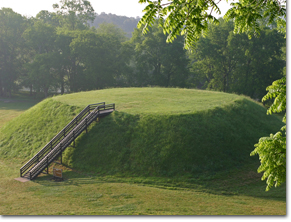
The Mississippian on the Georgia Piedmont is divided into Early (A.D. 900-1200), Middle (A.D. 1200-1350), and Late (1350-1540) (Hally and Rudolph 1986). The Spanish expeditions by DeSoto and DeLuna are considered to mark the end of the Mississippian period. The following Mississippian descriptions are derived from Hally and Rudolph (1986).

The Etowah Mounds site was at its greatest peak during the Middle Mississippian period. For more information on other sites during this period and their involvement in the Southern Ceremonial Complex, see our article under “Artifact Identification” and scroll down to “Ceremonial Objects.”
Etowah Complicated Stamped, Etowah Red Painted, Etowah Corn Cob Marked pottery
Etowah II is better defined than Etowah I. The age range of this phase is still uncertain with no purely Etowah II sites having been dated. Ceramic types associated with this phase include Etowah Complicated Stamped, Plain, Red Filmed, Polished Plain, and Polished Black; Sixes Plain; and Hiwassee Complicated Stamped and Red Filmed. The Hiwassee and Etowah series differ only in the tempering. The Etowah ceramics are sand tempered while the Hiwassee ceramics are shell tempered. At the Long Swamp site (9CK1) single post structures with associated circular clay hearths were reported. Some Etowah II occupation was found at the Etowah site (9BR1) in the form of deep refuse pits; however, no definite structures were found. The Etowah II phase has not been identified outside of the Etowah Valley.

The spread of the Etowah pottery extended into central Georgia while the later Savannah pottery is found across most of Georgia. Savannah Complicated Stamped is not typically found along the Chattahoochee River valley.
Etowah III was defined from investigations at the Etowah site (9BR1) and the Wilbanks site (9CK5). The construction of platform mounds at Etowah began at this time. Platform mounds and earthlodges have been reported from other Etowah III sites in both the Etowah and Coosawattee rivers. Smaller sites of this phase which do not contain either platform mounds or earthlodges are poorly known. The major differences between Etowah II and III ceramics are in the frequencies of decorative motifs and the appearance of new motifs. Some rectangular wall trench domestic structures have been described but there is generally little data on houses.
Savannah Check Stamped, Savannah Complicated Stamped, and Savannah Fine Cord Marked are the three most recognizable Savannah pottery types in Georgia.
The Savannah culture is the only identified Middle Mississippian culture in the Etowah River area. Savannah culture ceramic types include Savannah Plain, Check Stamped, and Complicated Stamped and Etowah Complicated Stamped. There is some argument as to whether the Savannah culture developed from the Etowah culture or represents a break from that earlier culture. There is growing evidence; however, that there is a gradual change from Etowah to Savannah. Southern Ceremonial Complex artifacts are found in mounds of the Savannah culture, this complex may have reached its peak at this time. In the Etowah River Valley the Savannah culture is represented by the Wilbanks phase.
The Etowah site reached its peak of political importance during this phase. This site contains the largest mound, the greatest number of mounds, and the widest variety of Southern Ceremonial Complex artifacts associated with the Savannah culture.